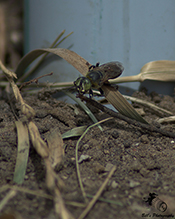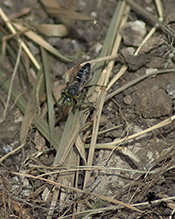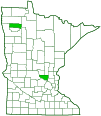crabronid wasp
(Tachytes pennsylvanicus)
Conservation • Description • Habitat • Ecology • Distribution • Taxonomy
|
|
||||||||||||||
Description |
Tachytes pennsylvanicus is a large crabronid wasp. It occurs in the United States east of the Great Plains and in Montana, South Dakota, and Nebraska. It occurs in southern Canada from British Columbia to Manitoba and in Quebec and Ontario. Adults are small, about 5⁄16″ (15 mm) in length. Females are larger than males. The body of both males and females is entirely black. The head is large. The compound eyes are large and dark. The mandibles (jaws) are black at the base. The antennae rise very low on the face. They consist of a long basal segment (scape), a small connecting segment (pedicel), and a long whip-like section (flagellum). On the female, the flagellum has 10 segments, on the male it has 11 segments. On the male, flagellomeres 8 and 9 (F8 and F9) are slightly broader than F10 and F11, but they are not unusually enlarged. The rear two ocelli (simple eyes) are not fully developed and are not functional as typical eyes. They appear as marks or impressions on the head and are consequently referred to as “scars.” This reduction of the hind ocelli is a defining characteristic of the tribe Larrini, to which the genus Tachytes belongs. The specific shape, length, and angle of these “scars” are important identifying characters for species within the tribe Larrini. The upper plates (terga) of the thorax, from anterior to posterior, are the pronotum (on the prothorax or first thoracic segment), the scutum and scutellum (both on the mesothorax or middle thoracic segment, with the scutellum positioned behind the scutum), and the metanotum (on the metathorax or third thoracic segment). The pronotum is characteristically short and collar-like. The scutum, which is large and prominent, has reflective hair-like processes (setae) on its sides and rear, but little or no setae (appearing as sparse pubescence) in its anteromedial region. The rear part of the body (metasoma) has little silvery pubescence toward the rear. The legs are entirely black with sparse silvery pubescence. On the hind legs, the third segment (femur) has no more than a few erect, hair-like setae, lacking the patches of long setae seen in some related species. On the hind tibiae of females, the spines are mostly slender, rather than peg-like. The wings are clear to slightly tinted brown, and they have dark veins. On the front wings, the end of the marginal cell is truncated, and there is only one submarginal cell. |
Size |
Total length: about 5⁄16″ (15 mm) |
Similar Species |
Habitat |
|
Ecology |
Season |
|
Behavior |
|
Life Cycle |
|
Larva Food |
|
Adult Food |
|
Distribution |
||
|
Sources |
|
| 7/30/2025 | ||
Occurrence |
||
|
||
Taxonomy |
|
Order |
Hymenoptera (Ants, Bees, Wasps, and Sawflies) |
Suborder |
Apocrita (Narrow-waisted Wasps, Ants, and Bees) |
Infraorder |
Aculeata (Ants, Bees, and Stinging Wasps) |
Superfamily |
Apoidea (Bees and Apoid Wasps) |
Family |
Crabronidae (Square-headed Wasps, Sand Wasps, and Allies) |
Subfamily |
|
Tribe |
Larrini |
Subtribe |
Gastrosericina |
Genus |
Tachytes |
Subordinate Taxa |
|
|
|
Synonyms |
|
Tachytes pepticus pennsylvanicus |
|
Common Names |
|
This species has no common name. Another common name of the Family Crabronidae is crabronid wasps, and it is applied here for convenience. |
|
Glossary
Femur
On insects and arachnids, the third, largest, most robust segment of the leg, coming immediately before the tibia. On humans, the thigh bone.
Flagellomere
A segment of the whip-like third section of an insect antenna (flagellum).
Ocellus
Simple eye; an eye with a single lens. Plural: ocelli.
Pubescence
On plants: the fuzzy hairs on a leaf, bud, stem, fruit, flower, or other structure. On insects and arachnids: the hair-like processes (setae) on the body.
Scutellum
The exoskeletal plate covering the rearward (posterior) part of the middle segment of the thorax in some insects. In Coleoptera, Hemiptera, and Homoptera, the dorsal, often triangular plate behind the pronotum and between the bases of the front wings. In Diptera, the exoskeletal plate between the abdomen and the thorax.
Scutum
The forward (anterior) portion of the middle segment of the thorax (mesonotum) in insects and some arachnids.
Seta
A stiff, hair-like process on the outer surface of an organism. In Lepidoptera: A usually rigid bristle- or hair-like outgrowth used to sense touch. In mosses: The stalk supporting a spore-bearing capsule and supplying it with nutrients. Plural: setae. Adjective: setose.
Tergum
The upper (dorsal) surface of a body segment of an arthropod. Plural: terga.
Tibia
The fourth segment of an insect leg, after the femur and before the tarsus (foot). The fifth segment of a spider leg or palp. Plural: tibiae.
Visitor Photos |
||
Share your photo of this insect. |
||
This button not working for you? |
||
Bill Reynolds |
||
Wasp By observing the behavior of this wasp and the size of it's eyes, I am assuming the wasp is a male. He has taken over a freshly disturb patch of soil and was actively chasing every flying insect out of his territory. He won't let me get very close, so I had to shoot from a distance. |
||
 |
 |
|
MinnesotaSeasons.com Photos |
||
|
||
|
||

Slideshows |
|

Visitor Videos |
||
Share your video of this insect. |
||
This button not working for you? |
||
|
Other Videos |
||
|

|
Created: 7/31/2025 Last Updated: © MinnesotaSeasons.com. All rights reserved. |


